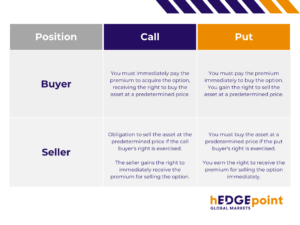What are the differences between call and put on the commodities market?
Learn about the differences between calls and puts, important financial instruments in the commodities market.
What are the differences between call and put? This is a question asked by even the most experienced traders.
These two terms are part of the options market and both are financial instruments in the group of derivatives traded on the stock exchange and the over-the-counter market. They give you the right to buy or sell a certain physical or financial asset.
Therefore, an option gives the holder (buyer) the right to exercise it, not the obligation. The option writer (seller), on the other hand, must carry out the exercise if the holder wishes to do so. This is the major distinction between the futures and forward markets, in which the holder is obliged to buy or sell the underlying asset.
Want to understand how call and put options work in practice? Then check them out:
- What are calls and puts?
- Comparative table with the main differences between them.
- The importance of risk management.
Read on to find out!
What is a call option?
Call options are a type of derivative traded all over the world. It is a security that gives the buyer the right to buy a certain asset at a predetermined price (strike) on a future date (expiry).
Two operations can be carried out with this tool: buying and selling calls. We explain each one below.
1. Call purchase
Let’s start by thinking from the point of view of the buyer of commodities, such as the soybean oil industry that needs to buy soybeans. Call options provide effective protection against possible price rises in international soybean prices.
When you buy a call, you guarantee the right to buy soybeans at a predetermined price, called the strike. If the price of soybeans is higher than the strike when the option expires, the holder can exercise it and guarantee to buy at the strike of their option. In other words, at a lower level than the current price.
In this way, buying a call makes it possible to protect yourself and make a profit when the price of the underlying asset rises. Another advantage of buying calls is that there is no need for margin deposits. You only pay the premium at the start of the trade, which is the price at which you bought the option.
Buying a call option allows the holder to make a positive financial adjustment as the underlying asset’s price rises. This is because it is based on the idea that exercise will occur at the price previously stipulated.
To make a profit on the expiry of the option in a scenario in which the asset rises in value, all the holders must do is exercise the option. They will be buying the underlying asset at a cheaper price, as established in the option contract. You can then sell the asset at a higher market price.
If the asset falls in value by the time the option expires, it makes no sense to exercise it at the price defined in the option but rather to buy the asset at the (lower) market price. In this situation, the option is not exercised, and the holder loses the amount he paid for his premium.
2. Call sales
Traders who sell calls have the prospect that, at expiry, the asset will depreciate enough for the price to be below the strike price.
As a result, the option loses value since it makes no sense for the buyer to exercise it. In this case, the seller will make the maximum profit from the operation, which is given by the premium. If the asset rises in value at expiry, the seller of the call will have to sell the asset at the strike price.
It is common for traders and speculators to sell call options when assets are in a downtrend. In this way, they seek to make a profit at expiry on the premium paid when selling the calls.
And what do put options mean?
Put options are sales options. In other words, it’s a security that gives the buyer the right to sell an asset at a predetermined price on a future date. As with call options, you can buy or sell puts. Below, we explain each one.

Call and put: risk management tools for business
Understanding the differences between call and put is essential for managing risks in the commodities market. This makes it possible to protect prices from volatility, which contributes to decision-making.
hEDGEpoint operates with knowledge of all commodity hedging instruments. We combine technology, insights, and data analysis to apply risk management tools.
On our exclusive platform, you’ll find courses from basic to advance to understand these instruments in detail.
Visit the hEDGEpoint HUB to find out more!






